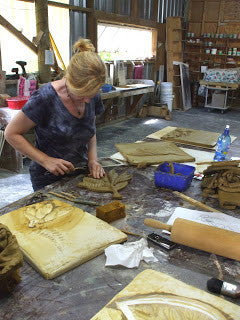
Earlier this month we were pleased to be able to bring Mariska de Jager on board as an Intern, to undertake a special project for us. Internships, a form of on the job training, are a great way for a student to get an insight into an industry and get some firsthand experience. Businesses benefit from a fresh pair of eyes and hands, and in our case, we were able to get a project under way that otherwise would have had to remain on the back burner. Mariska moved to New Zealand from Pretoria in South Africa seven years ago, and she and her family now live in Snells beach, handy to the Pottery. She’s a busy individual, balancing a job as a bookkeeper and studying part time at Auckland Studio Potters in Auckland, who manage the Diploma in Ceramics, from Otago Polytechnic.


Mariska has started her second year of this four year programme. One of the reasons we invited her into the pottery was her interest in figurative sculpture, as well as her growing expertise with ceramics. She describes clay as a wonderful medium, natural and challenging, a material that keeps you ‘humble’ as you constantly confront its many and varied characteristics. One of the things she likes about working with ceramics is the sense that as experience is gained, familiarity doesn’t expose limitations but seems to open up endless possibilities. This sense of curiosity and enthusiasm to find news answers is of course enormously useful to any enterprise. The project has been valuable for us, making us think about how we approach old problems and to revisit habitual ways of working; for Mariska we hope it has been an interesting insight into an environment that has much in common with Studio pottery, but also faces the challenge of production and short run manufacturing. Balancing these two things to remain viable whilst capturing and maintaining creative flair is at the core of our ongoing success. The project focused on a process that we haven’t actively used for a few years, sprig moulding.
Clay is pushed into a plaster mould to create low relief panels that are ‘glued’ with runny clay (slip) onto the pots. The technique is generally credited to John Astbury who applied the innovation to Staffordshire figures in the 18th century, and which was later refined by Josiah Wedgewood for use on his innovative jasperware. So the process has a interesting history. The challenge we offered Mariska was to produce some designs based on local flora, suitable for this technique. She had to think about a number of things while she researched and developed the designs, not least the thickness of the sculpted panel to ensure it stayed put whilst drying! Too thick and uneven drying will lead to cracking, something you can see in the first pot produced (top left). The first samples are drying now and we should get them fired and decorated in a week or two. Keep an eye out for the next post, which hopefully will have some of the finished work. We’ll also ask Mariska what she thought of her experience as a Morris & James Intern.



- Nick C

